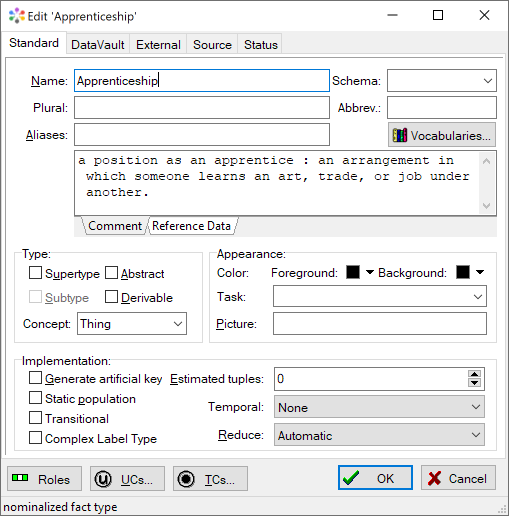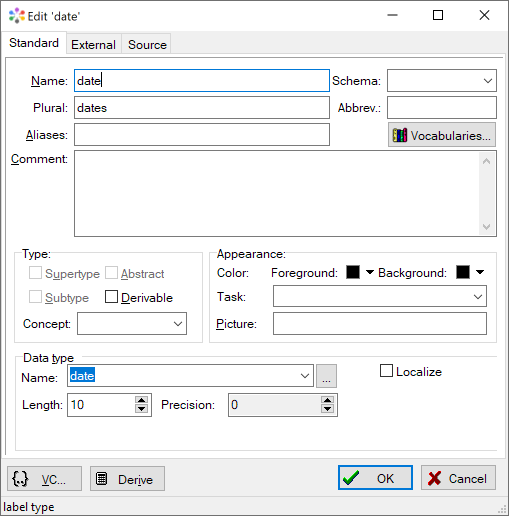Modeler: 12/OtftEditor
From CaseTalk Wiki
Object Type / Fact Type Editor
The dialog allows editing various default properties of Object/Fact Types.
- Name (Object/Fact/Label Type name)
- Schema (Names must be unique in combination with this Schema Name)
- Plural (Plural Name)
- Abbreviation (Abbreviated Name)
- Vocabularies (Translations and other wordings)
- Concept (Concept Type can be anything. Default provided are: Person, Location, Event, Thing)
- Aliases (Comma seperated list of Aliases for this OTFT)
- Comments and other annotations (Comments, and annotations as declared in Custom Attribute Definitions)
- Supertype, Abstract, Subtype (Specify if the Object Type a Supertype, Subtype or even Abstract.)
- Derivable (Mark this Object/Fact Type to be derivable.)
- Transitional (The population may be gathered from various sources, potentially conflicting. The artifacts will add a source_id column to the primary key.)
- Color and Background (Visual colors for personal use.)
- Task (The lifecycle specifier for this OTFT: Conceive, Plan, Develop, Qualify, Launch, Deliver, Retire)
- Temporal (Specify which temporal aspects are relevant: Valid Time, Transaction Time or Both.)
- Reducable (Modeler option to specify if this OTFT could, should, must be reduced during model transformation.)
- Generate Artificial Key (In the artifact this Type is required to be identifier using an artificial key. The natural key will become an alternate key.)
- Static Population (The population is considered to be static, as in a reference table.)
- Estimated Tuples (Estimated amount of tuples in the final artifact.)
Reference Data can be specified for easy population editing using the custom annotation as explained here.
Label Type Editor
Label Types contain different settings and this same dialog is presented differently for them:
The dialog for Label Types is slightly different, it lacks a few from the Object/Fact Type mode, and adds the following:
- Datatype Name (The datatype name can be specified using the ellipses button. This enables supporting datatypes for/from different artifacts.)
- Length
- Precision
- Localize (If set, the artifact will provide an additional database table to allow production data to be translated using a locale identifier. This is typically used for multi-lingual websites where product_name might need to be notated in various languages.)
Additionally Label Types may contain Value Constraints which limit the valid population.

